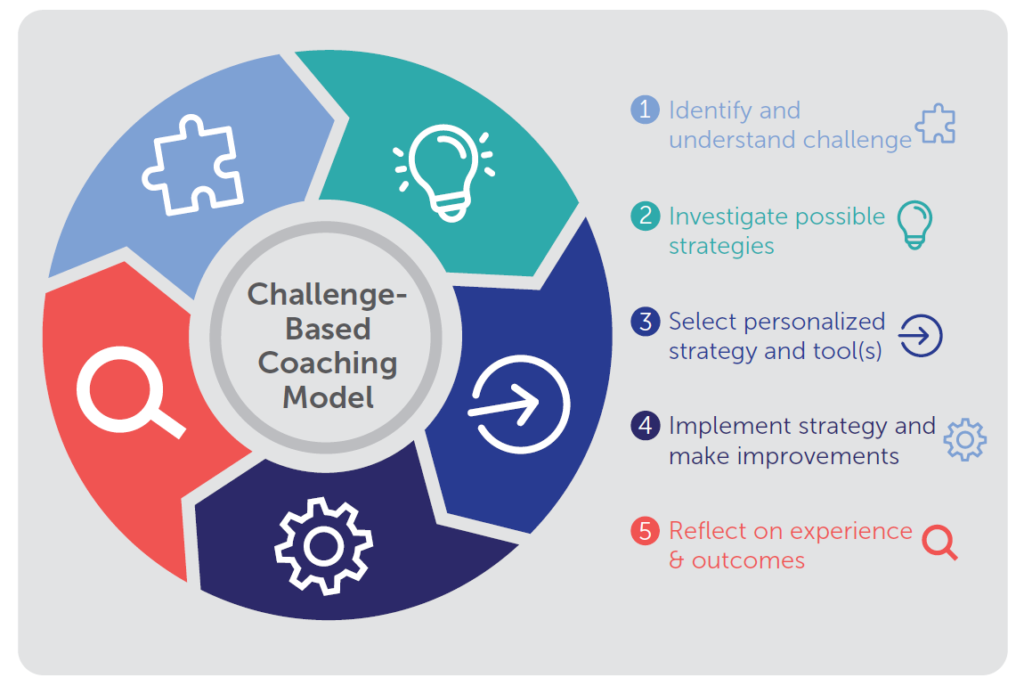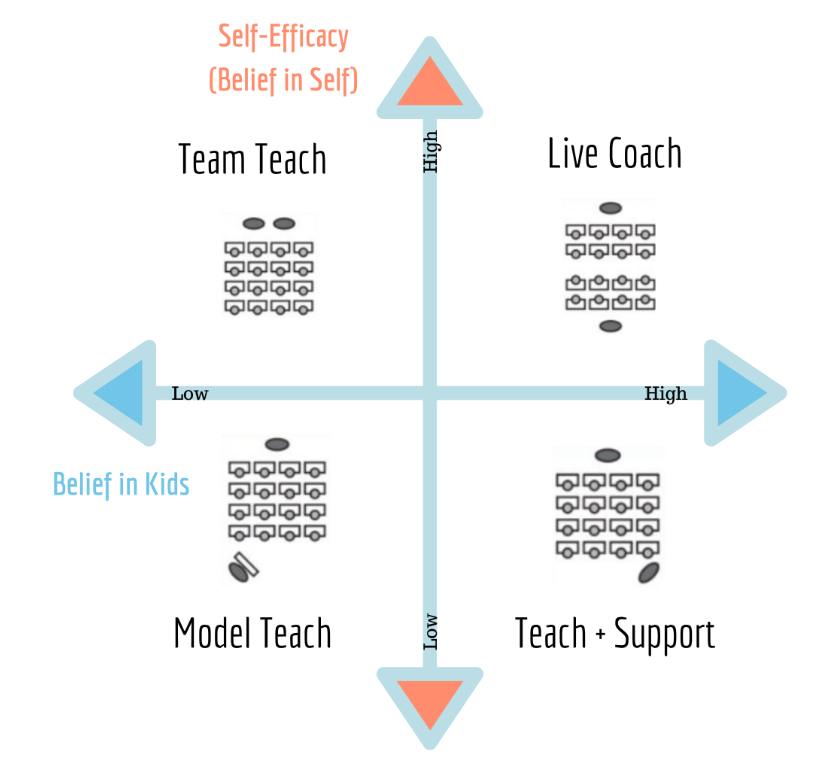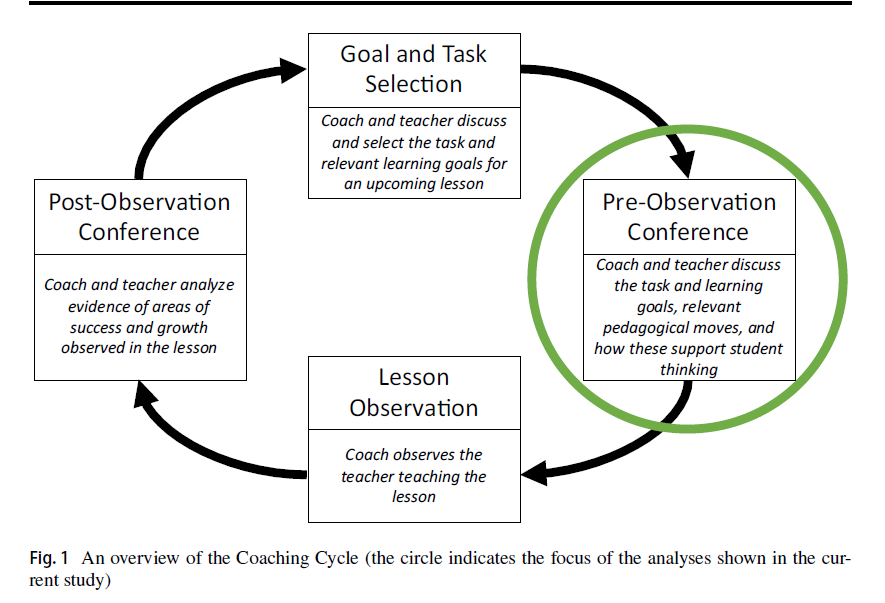For module 2 I have decided to investigate effective coaching strategies and how to personalize coaching to the needs of the teacher I am working with.
My questions are: as a digital educational coach, I wonder what are some effective strategies for coaching/teaching my fellow educators about new technology. Is modeling in a group of teachers more effective than modeling with a group of students while the teacher either observes or co-teaches a lesson? Additionally, I want to make sure that I am providing instruction that will truly benefit the educator and improve student learning. How can I personalize my instruction to meet their individual needs and the needs of their unique group of students?
These questions align with ISTE Coaching Standard 3: Collaborator. Specifically 3D: “Personalize support for educators by planning and modeling the effective use of technology to improve student learning” (ISTE, n.d.).
What is coaching?
First it is important to define what coaching looks like and how it is different from mentoring. According to Wong and Wong (2008), mentors have roles and coaches have responsibilities.
Coaches are more effective than mentors and are replacing mentors. Wong and Wong state that coaching should be customized to the needs of the teacher and/or school. The results of good coaching are that the teacher feels more motivated and willing to utilize their new skills when coaching is personalized, customized and ongoing (Wong & Wong, 2008).
Different coaching models

Lopez and Younge (2021) write about the challenge-based coaching model that was developed through Digital Promise and their Dynamic Learning Project. One of the reasons I like this model and the research that was conducted is because it has 9 rural schools and 1 urban school. I often struggle to find information on rural schools, which is my work setting, so I connected with the study on that personal/professional level. The Challenge-based Coaching Model is multi-step:
- Identify and understand challenge
- Investigate possible strategies
- Select personalized strategy and tool(s)
- Implement strategy and make improvements
- Reflect on experience & outcomes
Lopez and Younge (2021) also share conditions that support successful coaching: fewer classes assigned to the coach, commitment from school leaders, and enthusiasm from the teachers about the coaching work. This model is very much a collaborative approach of coach and teacher working hand in hand to problem solve. One of the things I really liked about this study is that it focused on scaffolded supports not only for the teachers being coached but also for the coaches.
Another coaching strategy is co-teaching. Lein (2022) advocates for instructional coaches to use co-teaching to support teachers. There are risks involved with co-teaching if the coach does not assess the situation correctly. It is important to have a good relationship and understanding of your role as a coach when co-teaching. Lien suggests utilizing a coaching matrix to make decisions on the best type of coaching based on the teachers self-efficacy and the extent that the teachers believe in their students. For low self-efficacy and low belief in kids Lein suggests model teaching (2022). For high self-efficacy and low belief in students, Lein suggests team teaching as an effective in the classroom coaching strategy. See matrix below.

Lein’s matrix is a reminder that in every coaching situation, it is vital that coaches spend time getting to know not only the teacher, but the students in the classroom as well. This will help when making coaching decisions, regardless of the coaching model chosen.
In a 2016 article in Education Week, suggests utilizing the SAMR model for technology coaching. In the article, coaches were focused on transforming traditional pen-and-paper work to tablets and computers. The coaches then demonstrated how to best implement the technology in the classroom through modeling a lesson with students. According to the article, successful coaching partnerships take trust and encourage risk. The risk comes from both the coach and the person being coached, both parties have to be willing to go outside of their comfort zones in order to experience growth. Good coaching relationships should result in growth from both parties. I especially like the use of the SAMR model because it focuses on transforming lessons. Not just changing a handwritten essay into a typed essay, but truly transforming/changing the lesson and hopefully making it better and more engaging through the use of technology.
Witherspoon et al. (2021) worked on a cognitive sciences based coaching method that includes 4 main stages: Goal and task selection, pre-observation conference, lesson observation, and post-observation conference. (insert image here). This cycle would be of value in any coaching relationship, not just one for technology coaches. It allows for teachers to directly ask for help, demonstrate what they are doing, and then work with the coach on how to make changes or improvements. This cycle is highly reflective in nature. The more the mentee can reflect on what they want from the coach, the better the coach will be able to meet their needs.

Finally, in a whitepaper written for ISTE, Beglau et al (2011) outline three models of coaching for technology coaches: cognitive coaching, instructional coaching and peer coaching. Each of these has its own benefits and it is important for the school or district to review and select the model that will work best for their teachers, students and coaches. There is no one-size-fits all approach to coaching, just like there is no one-size-fits all approach to teaching and learning.
In addition to coaching, Weinberg (2021) suggests weekly meetings when working in a mentoring/coaching relationship. Additionally, she suggests reciprocal teaching and learning between mentee and mentor (Weinberg, 2021). There are always things that we can learn from our fellow educators. I feel like this could go a long way to support good coaching relationships. Weinberg (2021) also proposes the use of live and recorded video to support visits to other classes. What I like best about this is that it would allow the coach to record multiple teachers utilizing whatever technology is being introduced to give the mentee multiple ways of doing something. I also like the idea of the coach filming themselves teaching so that the mentee can go back later and ask questions.
Through my research, I have found that in order to personalize my coaching to the educators in the room, I need to get to know them and what their personal needs are. I also need to know the students that the educators are working with. This information will help me, as a coach, to decide which coaching model works best for me and the situation, allowing me to personalize my coaching. Additionally, there is no best practice for modeling instruction. As each situation is unique, sometimes modeling will be the best solution, sometimes private observation will be best. Like so many aspects of life, with coaching it is important to “read the room.”
Resources
Beglau, M., Hare, J., Foltos, L., Gann, K., James, J., Jobe, H., Knight, J., & Smith, B. (2011). Technology, coaching and community: Power partners for improved professional development in primary and secondary education. International Society for Technology in Education. https://www.researchgate.net/publication/235679626
Education Week. (2016, June 9). Tech coaches model lessons. Education Week, 35(35). https://ezproxy.spu.edu/login?url=https://www.proquest.com/trade-journals/tech-coaches-model-lessons/docview/1797884807/se-2?accountid=2202
Ehsanipour, T., & Zaccarelli, F. (2017). Exploring coaching for powerful technology use in education.” Digital Promise. http://digitalpromise.org/wp-content/uploads/2017/07/Dynamic-Learning-Project-Paper-Final.pdf
International Society for Technology in Education. (n.d.). ISTE Standards: Coaches. International Society for Technology in Education. https://www.iste.org/standards/iste-standards-for-coaches
Lein, J. (2022, February 23). How instructional coaches can use co-teaching to support teachers: A matrix based on a teacher’s belief in themselves and their belief in students can facilitate effective instructional coaching. Edutopia. https://www.edutopia.org/article/how-instructional-coaches-can-use-co-teaching-support-teachers
Lopez, C., Younge, O. (2021). Cultivating a culture of coaching to support powerful use of technology: Results from the challenge-based coaching model pilot in Puerto Rico. Digital Promise. http://hdl.handle.net/20.500.12265/125
Tech coaches model lessons: Ed-tech mentors are becoming more common inside classrooms, where they are observing, co-teaching, and sharing their knowledge about how to use digital tools. (2016). Education Week, 35(35) Retrieved from https://ezproxy.spu.edu/login
Weinberg, A. (2021, July). 3 strategies for productive teacher mentoring: Experienced teachers and those new to the profession benefit from collaboration and learning that goes in both directions. Edutopia. https://www.edutopia.org/article/3-strategies-productive-teacher-mentoring
Witherspoon, E., Ferrer, N., Correnti, R., Stein, M., & Schunn, C. (2021). Coaching that supports teachers’ learning to enact ambitious instruction. Instructional Science, 49, 877-898. https://doi.org/10.1007/s11251-021-09536-7
Wong, H. & Wong, R. (2008). Coaches are more effective than mentors. Teachers.net. http://teachers.net/wong/FEB08/.

3 replies on “Coaching Strategies & Models”
I like the model of coaching, especially among colleagues at schools. It should be personalized, customized and ongoing. I think as teachers, we do a pretty good job at personalizing our approaches and customizing the support so it fits who we are coaching. But at times, we do not keep up with the ongoing portion. Coaching that is consistent, tailor-made and relevant to those being coached brings the utmost impact.
I completely agree with you Chelly. The most important thing is definitely that it is ongoing and I would even say, ever developing.
Thanks for elaborating the coaching models and strategies comprehensively. I learned a lot from this post. I believe that a coach needs to select and modify appropriate model and strategy for the coaching participants. Also, a follow-up program should be provided to maintain the sustainability of professional development.